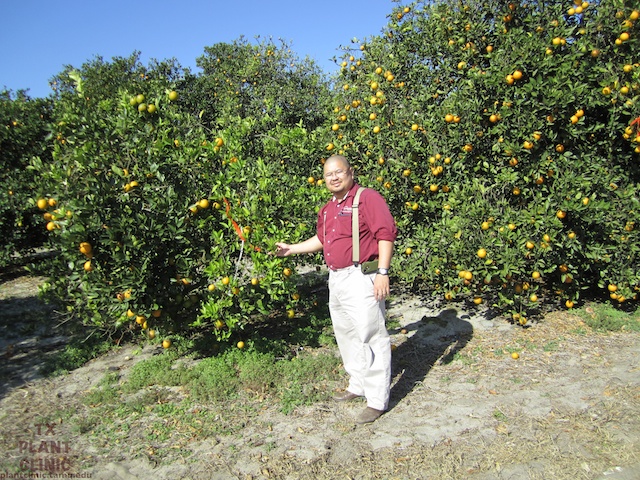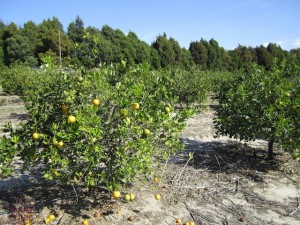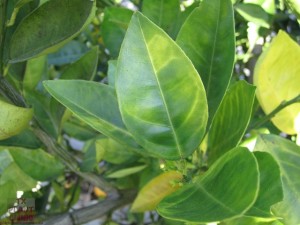
A CG infected tree and I. Notice the light green/yellow branch and the size of that tree in comparison with the one next to it.
A week ago I was sitting in meetings in Florida. This was a trip with other researchers, extension personnel and citrus growers from Texas to the University of Florida Citrus Research & Extension Center in Lake Alfred. The discussion included various lesson learned from the situation in Florida. These information were shared by their research, extension personnel and the Florida citrus growers. Their situation was unique in that Citrus Greening (CG) first hit Florida in 2005. At that time, they did not know much about the disease and how it would affect the orange tree, nor did they know of good effective management methods.
Some of the lessons learned there has helped Texas to stave off the disease a little longer such as the importance of insect vector (Asian Citrus Psyllid) management by area-wide spray program. Texas AgriLife Extension Service has also been busy around the state educating volunteers and the general public to this disease, soliciting help to detect this problem early and to understand the need to not “import” plants from affected states such as Florida. Now that CG is in Texas, what next? It was interesting to note that the Floridians encouraged continued vigilance for early detection and aggressiveness in response. Essentially two possible responses to go along with an aggressive psyllid spray program: (1) Rogue/destroy infected plant as soon as they are identified or (2)Nutritional therapy – where management and delivery so nutrients to the plant can help the tree to continue to produce (even in the presence of the bacterial causal agent).
So what now? What do we need to do now that the disease is in Texas?

Affected trees (7 year old) in a relatively new grove. Note the fruit drop and sparse foliage. What you might not have realized is that the tree should be 2-3 time that size. Admission by the grower that they did not act until 30% of the groove was affected. By then it was more difficult to limit and manage the problem.
The situation currently is that Texas Department of Agriculture placed an emergency quarantine zone of 5-mile radius from the “hot spot”. This is a small area when you consider how big Texas is. Texas Citrus growers in the Rio Grande Valley (RGV) are participating in area-wide spray to stop movement of the psyllids. Texas AgriLife Extension Service agents and volunteers there are busy trying to get the word out to homeowners and encourage them to treat their backyard citrus plants as well. A spray program is only effective when you limit (or eliminate) any sanctuary for the insect vector. Furthermore, all of us who have a citrus bearing plant or two in our backyard do WANT fruit. This disease can and usually will result in fruit drop and eventual plant death. The scary part is that a homeowner may lose production in one or few trees in their backyard, but a commercial grower could potentially lose their livelihood.
Citrus Greening, aka Huanglongbing, disease is in Texas. It is still localized. All of us in Texas still have important roles to play to ensure that this disease stays limited. Preventative and proactive actions seems natural to those in the commercial citrus growing area of this state. For the rest of us, it is still important to keep our eyes open for possible symptoms. Still, do not “import” citrus plants from affected states such as Florida and Louisiana, AND the quarantine part of Texas (Hidalgo county). Beside it is against the law – there is a Federal Order against the movement of plant material from quarantined states. It may be obvious that this problem is of more importance in parts of east Texas and the gulf coast where citrus can be grown. But all of us in Texas can participate in keeping our citrus safe.

A characteristic foliar symptom caused by CG on orange tree is leaf mottling that is uneven. Note the lack of symmetry (one side of the midrib is different from the other) in the damage on this leaf.
If you do see or suspect Citrus Greening, please contact Texas Department of Agriculture or your local AgriLife Extension Service office. They can collect and submit samples for further testing at the Texas Plant Disease Diagnostic Lab (a NPDN-member lab).
For more information about Citrus Greening, check out the following citrus resource page on the plant clinic website. Additional information can be found at:
http://texascitrusgreening.org
If you are interested in learning more about the history of this disease: how it came in FL and the damage it caused, and other related stuff, check out the Florida Department of Plant Industry website on Citrus Health Response.
Photos were taken last week in Polk County, FL.



